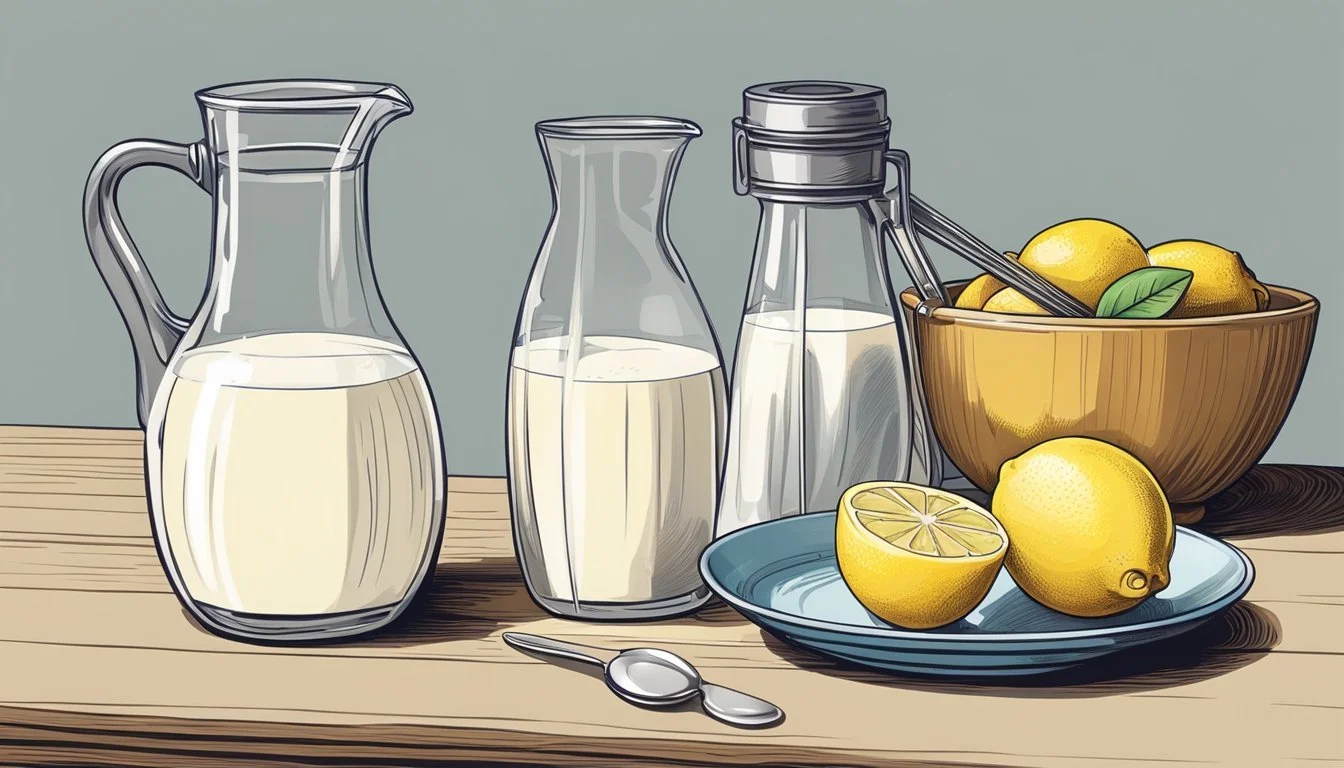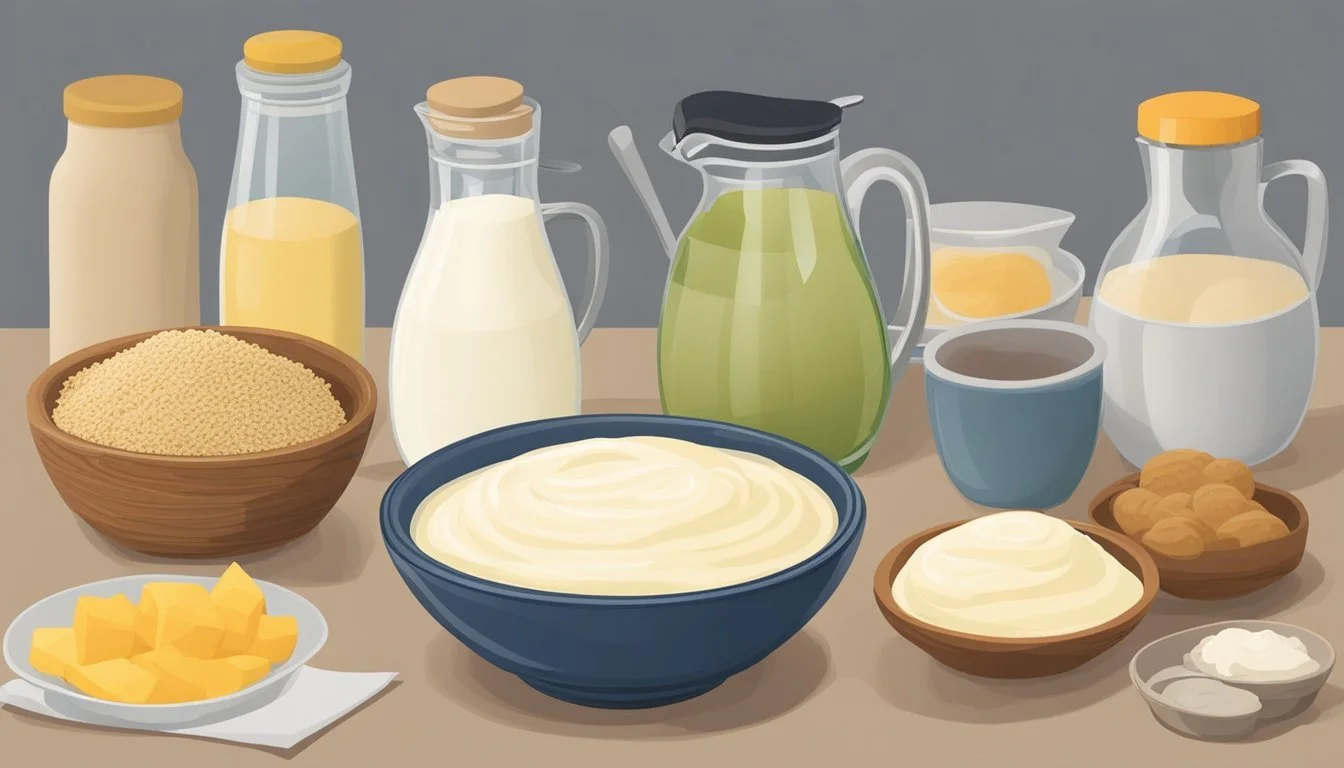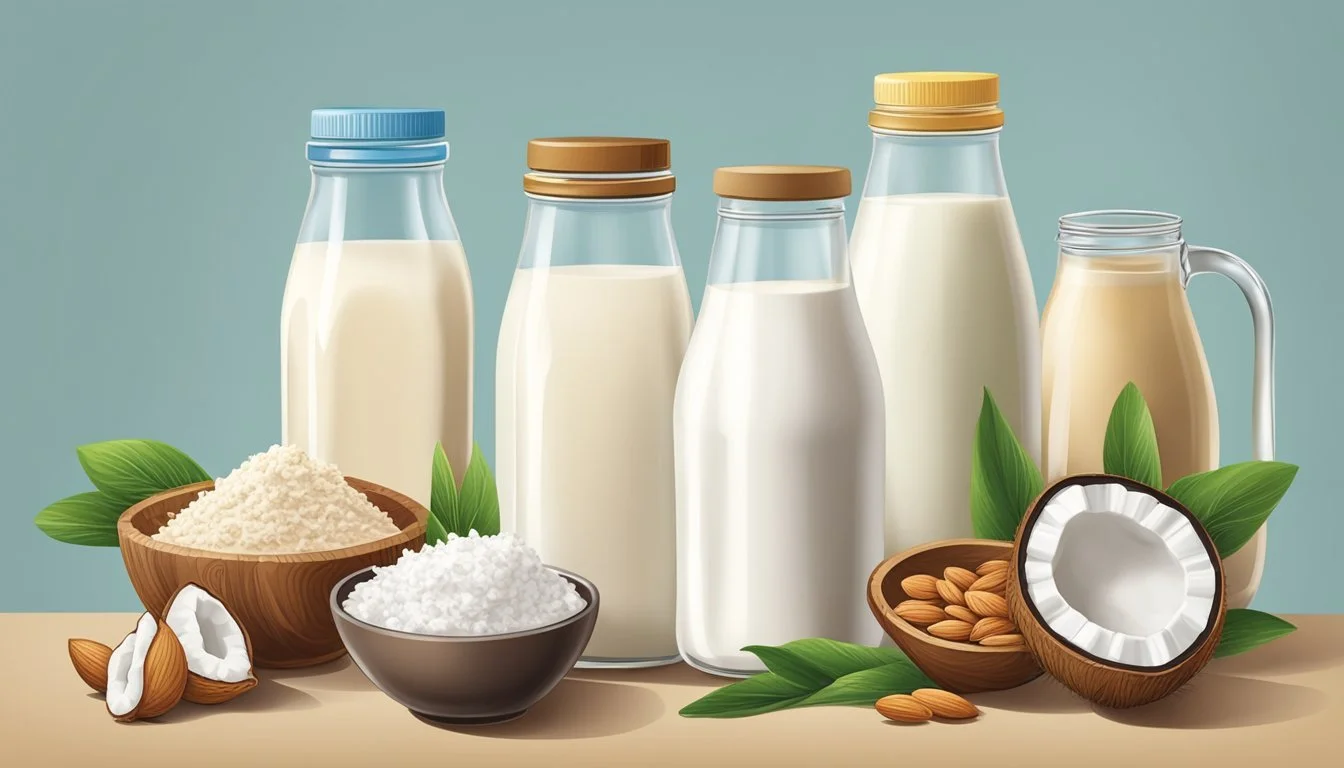Buttermilk Substitutes
Top Alternatives for Your Recipes
Buttermilk has long been a staple in many recipes, known for imparting a tangy richness that enhances flavors and textures, especially in baked goods. Its acidic content contributes to the leavening process, tenderizing gluten and making batters lighter and more flavorful. However, buttermilk isn’t always on hand in every kitchen, and for those with dietary restrictions, it may not be an option. This is where the utility of buttermilk substitutes becomes apparent.
A variety of alternatives can mimic the properties of buttermilk. Common pantry items like milk mixed with lemon juice or vinegar are often used to create a quick and simple replacement. This combination, allowed to sit for a few minutes, thickens and takes on the slightly tangy character of buttermilk. Dairy-free versions can involve plant-based milks combined with an acid, catering also to those avoiding dairy. Another method includes blending yogurt or sour cream with water to achieve a similar consistency and acidity to that of buttermilk, which can be particularly useful in dressings and marinades.
Understanding how to use these substitutes effectively ensures that the absence of buttermilk does not compromise the quality of a dish. Each alternative brings a similar acidity that is crucial for the leavening in baking and can provide the desired texture and flavor. Through selecting the right substitute and understanding the correct ratios, the functionality of buttermilk in recipes can be replicated successfully, maintaining the integrity of the final product.
Benefits of Buttermilk in Baking
Buttermilk plays a crucial role in baking, enhancing both the taste and texture of baked goods, while also interacting with leavening agents to create the perfect rise.
Role in Texture and Flavor
Buttermilk imparts a distinctively tangy flavor that enhances the overall taste profile of baked items. The acidity of buttermilk tenderizes gluten in the flour, resulting in a softer and more tender crumb. It adds a subtle, yet rich, complexity that balances sweetness and adds depth to flavors. The presence of lactic acid bacteria in buttermilk contributes to its unique taste, distinguishing it from other dairy products.
Chemical Reactions with Leavening Agents
In baking, buttermilk reacts with leavening agents like baking soda to produce carbon dioxide gas. This chemical reaction is crucial as it helps to raise and lighten the texture of baked goods. The acidity in buttermilk is essential for the reaction to occur, which is why substitutes such as lemon juice or vinegar are often combined with milk to mimic this effect. Buttermilk works similarly with baking powder, as it contains both an acid and a base that react to create the necessary lift. The moisture from buttermilk also helps to dissolve sugar and gelatinize starches, contributing to the desired consistency in the finished product.
Dairy-Based Buttermilk Alternatives
Dairy-based buttermilk alternatives are common in recipes that require the tangy flavor and tenderizing properties of buttermilk. These alternatives utilize various dairy products such as yogurt, sour cream, and milk in combination with an acid to simulate the effects of buttermilk in cooking and baking.
Yogurt-Based Substitutes
Plain Yogurt and Milk: To achieve a buttermilk-like consistency and flavor, one can mix two parts plain yogurt with one part milk. For a thicker result, Greek yogurt can be used.
Greek Yogurt Thinned Out: Greek yogurt alone is too thick to replace buttermilk directly. Thin it with milk until it reaches the desired consistency comparable to that of buttermilk.
Soured Milk Variants
Milk and Lemon Juice: Add 1 tablespoon of lemon juice to 1 cup of milk, stir, and let stand for 5 minutes.
Milk and Vinegar: Combine 1 cup of whole milk with 1 tablespoon of white vinegar, allow it to sit for approximately 5 minutes until slightly curdled.
Soured Milk with Cream of Tartar: Mix 1 and 3/4 teaspoon of cream of tartar with 1 cup of milk to sour and thicken the milk to mimic buttermilk's properties.
Cream-Based Options
Sour Cream:
Dilute sour cream with water or milk to reach a buttermilk-like consistency. A ratio of 3 parts sour cream to 1 part liquid usually works well.
Powdered Buttermilk:
When available, powdered buttermilk can be reconstituted with water according to package directions to replace liquid buttermilk in recipes. This powder is often made from cultured buttermilk, offering a similar taste profile to the liquid form.
Non-Dairy Buttermilk Substitutes
For those with dairy restrictions or dietary choices, creating a non-dairy buttermilk substitute is quite simple using plant-based milk and some added acidity to replicate the taste and texture of traditional buttermilk. These options cater to vegan diets and are suitable for most baking and cooking needs.
Plant Milk Solutions
When selecting a non-dairy milk to use as a buttermilk substitute, it's important to choose one with a neutral or mild flavor. The following plant milks make excellent bases:
Almond milk: Mild in flavor and slightly sweet, its consistency works well in recipes.
Soy milk: With a creamier texture, soy milk mirrors the thickness of buttermilk closely.
Coconut milk: For those preferring a hint of coconut flavor, this milk lends a unique taste to recipes.
Oat milk: Known for its smooth texture and light sweetness, oat milk is a good all-purpose substitute.
Rice milk: Lighter in body, it's best used for recipes that do not require the thickness that buttermilk would provide.
All options should be unsweetened and, if possible, unflavored to avoid altering the intended taste of your recipe.
Acidic Additions for Vegan Recipes
The key to turning plant milk into a vegan buttermilk substitute lies in the introduction of an acid to curdle the milk, inducing the tangy flavor buttermilk is known for. Here's how to do it:
Vinegar: Add 1 tablespoon of white or apple cider vinegar to 1 cup of non-dairy milk, stir, and let sit for 5-10 minutes.
Lemon juice: A tablespoon of lemon juice per cup of plant milk can also achieve the desired effect. Let it rest to thicken slightly.
After mixing the plant milk with an acidic agent, it should begin to curdle, forming the perfect non-dairy buttermilk substitute that can be used immediately in baking or cooking.
Substitutes in Different Recipes
When they find themselves without buttermilk, home cooks can turn to simple kitchen staples to achieve similar taste and texture in various dishes requiring this ingredient.
Buttermilk in Pancakes and Waffles
For fluffy buttermilk pancakes or waffles, the acid in buttermilk is crucial for leavening. A quick mix of milk and lemon juice or white vinegar mimics this acidity. Use 1 tablespoon of either acid mixed with enough milk to make 1 cup. Allow the solution to sit for a few minutes before incorporating it into your batter.
Using Substitutes in Cakes and Muffins
In baking cakes and muffins, buttermilk's acidity tenderizes gluten, giving baked goods a soft texture. A suitable substitute for buttermilk here is milk combined with cream of tartar; 1 and ¾ teaspoons per cup of milk. This combination requires thorough mixing and a few minutes to sit, integrating the properties needed to replace buttermilk.
Dressings and Marinades Alternatives
Buttermilk imparts a tangy flavor and creamy texture to dressings like ranch, and acts as a tenderizing agent in marinades. In these liquid-based recipes, a thicker substitute like plain yogurt or sour cream diluted with a bit of milk or water can provide the creamy consistency and the tang needed.
Variations for Biscuits and Breads
Achieving the tender crumb of buttermilk biscuits and bread can be challenging without the real thing. However, the milk and acid combination works well here too. For a richer alternative, use sour cream or plain yogurt mixed with a little milk or water to maintain the dough's moisture without thinning it too much.
Storage and Shelf Life of Buttermilk and its Substitutes
Proper storage is crucial for maintaining the quality of buttermilk and its substitutes. Refrigeration and freezing play key roles in extending their shelf life.
Refrigeration Tips
When it comes to refrigeration, buttermilk should be stored at 40°F (4°C) or below. This temperature range is essential for inhibiting the growth of bacteria that can spoil the product. For homemade buttermilk substitutes like milk combined with lemon juice or vinegar, the same refrigeration guidelines apply. One should transfer the substitute into an airtight container before placing it in the refrigerator to preserve freshness.
Recommended Refrigeration Temperature: 40°F (4°C)
Airtight Container Usage: Crucial for longevity
Freezing Guide
Freezing buttermilk extends its usability beyond the refrigeration period, up to 3 months, without significantly compromising its quality. Ideally, one should freeze buttermilk in small quantities, such as in an ice cube tray, for ease of use later. To thaw, transfer it from the freezer to the fridge, allowing up to 24 hours for complete defrosting.
Freezing Temperature: 0°F (-18°C) or below
Shelf Life When Frozen: Up to 3 months
Thawing Method: In the fridge up to 24 hours
Making Buttermilk Substitutes at Home
In the absence of traditional buttermilk, one can reliably use a combination of milk and acidic ingredients found in most kitchens to create effective substitutes. These alternatives are not only convenient but also versatile for a variety of cooking and baking needs.
Quick Fixes with Common Ingredients
For most recipes, the easiest way to replicate buttermilk is by acidulating milk. This process involves adding an acid to milk to slightly curdle it, mimicking the tangy flavor and increased acidity of buttermilk.
Milk + Lemon Juice: Combine 1 cup of milk with 1 tablespoon of lemon juice. Let the mixture sit for about 5 minutes until it thickens slightly and curdles.
Quantity of Milk Amount of Lemon Juice 1 cup 1 tablespoon
Milk + White Vinegar or Apple Cider Vinegar: White vinegar can also be used in place of lemon juice. For a subtler tang, one can opt for apple cider vinegar.
Quantity of Milk Amount of Vinegar 1 cup 1 tablespoon
These substitutions work well for baked goods such as bread, cakes, or pancakes where buttermilk's unique properties are not the sole key to the recipe's success.
Creating Thicker Consistencies
To achieve a consistency closer to that of traditional buttermilk, which is slightly thicker than milk, alternative methods or ingredients may be necessary. These substitutions are favored in recipes where a thicker consistency contributes to the texture of the final product, such as in dressings or marinades.
Milk + Cream of Tartar: Add 1-1/2 teaspoons of cream of tartar to 1 cup of milk. Stir and let the mixture stand until thickened.
Quantity of Milk Amount of Cream of Tartar 1 cup 1-1/2 teaspoons
Sour Milk: Sour milk is a traditional byproduct of churning butter or by the intentional addition of lactic acid bacteria to milk. However, it can be simulated by adding an acid to milk as described above.
By utilizing common kitchen staples such as milk, lemon juice, and vinegar, home cooks can effortlessly craft a substitute for buttermilk. Each method offers a different thickness and tang, allowing for fine-tuning depending on the requirements of the recipe at hand.
Special Considerations for Dietary Needs
When seeking buttermilk substitutes, individuals with specific dietary restrictions, such as gluten intolerance or dairy allergies, as well as those following a vegan lifestyle, have a variety of options to consider to ensure their recipes are safe and satisfying.
Gluten-Free and Allergy-Friendly Options
For those who are gluten-sensitive or allergic to certain ingredients, non-dairy milks such as soy milk, almond milk, and oat milk serve as excellent bases for homemade buttermilk substitutes. They are naturally gluten-free, but it's essential to check the labels for potential cross-contamination if you have celiac disease or a severe gluten intolerance. To mimic buttermilk:
Mix 1 tablespoon of acid (lemon juice or white vinegar) with 1 cup of the non-dairy milk of your choice.
Allow the mixture to sit for 5-10 minutes until it thickens and curdles slightly.
Vegan and Dairy-Free Choices
For those on a dairy-free or vegan diet, finding an appropriate buttermilk substitute is crucial for maintaining the integrity of their diet while still enjoying buttermilk's culinary benefits. Vegan buttermilk substitute can be made using various nondairy milks, including:
Soy milk, due to its similar protein content to cow's milk, curdles well and offers a rich texture.
Almond milk and coconut milk can also be used; however, they may impart a slight nutty or coconut flavor to the end product.
Oat milk is another option that provides a neutral flavor and creamy consistency.
To create a vegan buttermilk substitute:
Add 1 tablespoon of acid (such as lemon juice or apple cider vinegar) to 1 cup of your selected nondairy milk.
Stir and let the mixture rest until it curdles and thickens, which takes about 5 to 10 minutes.
FAQs on Buttermilk and Substitutes
What is a quick buttermilk substitute I can make at home? A common substitute for buttermilk is regular milk mixed with an acid. One can add 1 tablespoon of lemon juice or white vinegar to 1 cup of milk and let it sit until slightly thickened.
Can I use buttermilk powder in place of liquid buttermilk? Yes, buttermilk powder can be used in place of liquid buttermilk. The powder should be reconstituted according to package instructions, typically mixing a specified amount of powder with water.
What role does buttermilk play in recipes like coffee cake? Buttermilk acts as a leavening agent in conjunction with baking soda, helping baked goods like coffee cakes rise and achieve a tender crumb.
Is potassium bitartrate useful as a buttermilk substitute? Also known as cream of tartar, potassium bitartrate can be used with milk to replicate buttermilk's acidity. Mix approximately 1 3/4 teaspoons with 1 cup of milk.
How does the acidity of buttermilk substitutes affect baking? The acidity in buttermilk substitutes, such as lemon juice or vinegar, reacts with baking soda to produce carbon dioxide, which helps baked goods rise.
Are there dairy-free alternatives for buttermilk in baking? One can use plant-based milks mixed with an acid like lemon juice or vinegar in a 1 cup to 1 tablespoon ratio as a dairy-free substitute.
Conclusion
In the absence of buttermilk, home cooks can confidently turn to various alternatives without sacrificing quality. Milk mixed with an acid is the cornerstone of most buttermilk substitutes, offering a similar tang and ability to tenderize baked goods.
A common mixture involves adding 1 tablespoon of lemon juice or white vinegar to 1 cup of milk, allowing the mixture to sit for 5–10 minutes. The resulting curdled milk mimics buttermilk's consistency and acidity.
For those seeking a dairy-free option, soy or almond milk can be acidulated in the same fashion.
In recipes calling for a thicker consistency, yogurt or sour cream diluted with water serves as a viable substitute.
These home remedies provide the desired leavening effect and the characteristic buttermilk tang, ensuring the outcome of recipes remains unchanged. Chefs recommend using these substitutes in the same quantity as buttermilk called for in the recipe.
Here's a quick reference table for substitution ratios:
Substitute Ratio (to make 1 cup) Lemon Juice + Milk 1 tablespoon lemon juice + enough milk to make 1 cup White Vinegar + Milk 1 tablespoon white vinegar + enough milk to make 1 cup Yogurt + Water 3/4 cup yogurt + 1/4 cup water Sour Cream + Water 3/4 cup sour cream + 1/4 cup water Non-dairy milk + Acid 1 tablespoon acid + enough non-dairy milk to make 1 cup
Maintaining these proportions ensures the integrity of recipes is preserved, helping to achieve a result close to the intended flavor and texture when buttermilk is not on hand.




